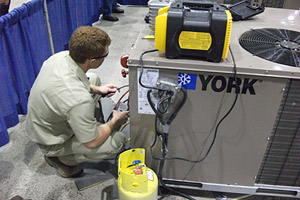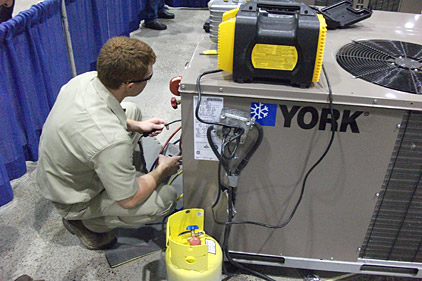
|
| Proper handling of HCFC-22 is a focus at the annual SkillsUSA competition in Kansas City, Mo. Such attention is becoming even more important as the industry is dealing with misuse of alternative refrigerants in R-22 systems. |
The dramatic market shift away from HCFC-22 has given rise to a number of new refrigerant options for distributors to sell and technicians to use. Many in the air conditioning and refrigeration industry were not prepared for the transition to an alternative refrigerant and the bombardment of new refrigerant options to choose from continues to make their jobs even harder.
The fastest-growing and most-troubling concern being reported today is the practice of mixing alternative refrigerants with R-22. This practice is considered highly irresponsible and unacceptable by the mainstream refrigerant industry, and for a number of good reasons. ICOR has received numerous reports from technicians claiming they were told by a distributor, or even worse, a refrigerant manufacturer’s representative, that it is acceptable to mix an alternative refrigerant with R-22. Although several individuals claim they were given a green light to mix directly from a manufacturer’s representative, we believe it is the result of selective listening and/or miscommunication, rather than a conscious effort by anyone to encourage mixing.
The primary concern with mixing R-22 with an HFC alternative is the unpredictable change in the pressure-temperature relationship. HFC-based alternative refrigerants are comprised of no less than two refrigerants, and some have a blend of as many as five refrigerants. They have been developed in a way that, when properly used in their pure form and in a qualified application, they will mimic the operational characteristics of R-22. However, even in their pure form (not mixed with R-22) they will not provide adequate performance unless the refrigerant charge has been optimized by using the refrigerant’s respective pressure-temperature chart and the superheat or subcooling calculation method. When an alternative refrigerant is mixed with R-22, there is no pressure-temperature chart to refer to and therefore no way to optimize the system charge. Improper superheat or subcooling can lead to compressor floodback, overheating, and dramatically reduce system efficiency and compressor lifetime.
Mixing any HFC alternative refrigerant with R-22, in any concentration, is a formula for failure and should be discouraged industry-wide. Any statement made to the contrary is highly irresponsible and the result of poor communication, inadequate education, or misguided self-interest.
For more information regarding proper refrigerant use and any information in this article, contact ICOR’s Tech-2-Tech support hotline at 866-433-8324. You can also email questions or comments to icorinfo@icorinternational.com.
Publication date: 7/15/2013


Report Abusive Comment